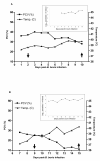The Rhipicephalus (Boophilus) microplus Bm86 gene plays a critical role in the fitness of ticks fed on cattle during acute Babesia bovis infection
- PMID: 21092112
- PMCID: PMC2994843
- DOI: 10.1186/1756-3305-3-111
The Rhipicephalus (Boophilus) microplus Bm86 gene plays a critical role in the fitness of ticks fed on cattle during acute Babesia bovis infection
Abstract
Background: Rhipicephalus (Boophilus) microplus is an economically important tick of cattle involved in the transmission of Babesia bovis, the etiological agent of bovine babesiosis. Commercial anti-tick vaccines based on the R. microplus Bm86 glycoprotein have shown some effect in controlling tick infestation; however their efficacy as a stand-alone solution for tick control has been questioned. Understanding the role of the Bm86 gene product in tick biology is critical to identifying additional methods to utilize Bm86 to reduce R. microplus infestation and babesia transmission. Additionally, the role played by Bm86 in R. microplus fitness during B. bovis infection is unknown.
Results: Here we describe in two independent experiments that RNA interference-mediated silencing of Bm86 decreased the fitness of R. microplus females fed on cattle during acute B. bovis infection. Notably, Bm86 silencing decreased the number and survival of engorged females, and decreased the weight of egg masses. However, gene silencing had no significant effect on the efficiency of transovarial transmission of B. bovis from surviving female ticks to their larval offspring. The results also show that Bm86 is expressed, in addition to gut cells, in larvae, nymphs, adult males and ovaries of partially engorged adult R. microplus females, and its expression was significantly down-regulated in ovaries of ticks fed on B. bovis-infected cattle.
Conclusion: The R. microplus Bm86 gene plays a critical role during tick feeding and after repletion during blood digestion in ticks fed on cattle during acute B. bovis infection. Therefore, the data indirectly support the rationale for using Bm86-based vaccines, perhaps in combination with acaricides, to control tick infestation particularly in B. bovis endemic areas.
Figures






Similar articles
-
Targeted silencing of the Aquaporin 2 gene of Rhipicephalus (Boophilus) microplus reduces tick fitness.Parasit Vectors. 2015 Dec 2;8:618. doi: 10.1186/s13071-015-1226-2. Parasit Vectors. 2015. PMID: 26626727 Free PMC article.
-
Silencing of a putative immunophilin gene in the cattle tick Rhipicephalus (Boophilus) microplus increases the infection rate of Babesia bovis in larval progeny.Parasit Vectors. 2009 Nov 20;2(1):57. doi: 10.1186/1756-3305-2-57. Parasit Vectors. 2009. PMID: 19930572 Free PMC article.
-
The ovarian transcriptome of the cattle tick, Rhipicephalus (Boophilus) microplus, feeding upon a bovine host infected with Babesia bovis.Parasit Vectors. 2013 Sep 23;6:276. doi: 10.1186/1756-3305-6-276. Parasit Vectors. 2013. PMID: 24330595 Free PMC article.
-
More than Three Decades of Bm86: What We Know and Where to Go.Pathogens. 2023 Aug 22;12(9):1071. doi: 10.3390/pathogens12091071. Pathogens. 2023. PMID: 37764879 Free PMC article. Review.
-
Cocktail Anti-Tick Vaccines: The Unforeseen Constraints and Approaches toward Enhanced Efficacies.Vaccines (Basel). 2020 Aug 19;8(3):457. doi: 10.3390/vaccines8030457. Vaccines (Basel). 2020. PMID: 32824962 Free PMC article. Review.
Cited by
-
Antibodies against EGF-like domains in Ixodes scapularis BM86 orthologs impact tick feeding and survival of Borrelia burgdorferi.Sci Rep. 2021 Mar 17;11(1):6095. doi: 10.1038/s41598-021-85624-5. Sci Rep. 2021. PMID: 33731754 Free PMC article.
-
Detection of Babesia bovis in blood samples and its effect on the hematological and serum biochemical profile in large ruminants from Southern Punjab.Asian Pac J Trop Biomed. 2012 Feb;2(2):104-8. doi: 10.1016/S2221-1691(11)60202-5. Asian Pac J Trop Biomed. 2012. PMID: 23569878 Free PMC article.
-
Development and field evaluation of PCR assays based on minimum length Bm86 cDNA fragments required for Rhipicephalus and Hyalomma tick species delineation.Front Vet Sci. 2023 Jun 29;10:1209210. doi: 10.3389/fvets.2023.1209210. eCollection 2023. Front Vet Sci. 2023. PMID: 37456966 Free PMC article.
-
Knockdown of the Rhipicephalus microplus cytochrome c oxidase subunit III gene is associated with a failure of Anaplasma marginale transmission.PLoS One. 2014 May 30;9(5):e98614. doi: 10.1371/journal.pone.0098614. eCollection 2014. PLoS One. 2014. PMID: 24878588 Free PMC article.
-
A new method for in vitro feeding of Rhipicephalus australis (formerly Rhipicephalus microplus) larvae: a valuable tool for tick vaccine development.Parasit Vectors. 2017 Mar 23;10(1):153. doi: 10.1186/s13071-017-2081-0. Parasit Vectors. 2017. PMID: 28335800 Free PMC article.
References
-
- Friedhoff K. In: Babesiosis of Domestic Animals and Man. Ristic M, editor. Boca Raton, FL, USA: CRC Press; 1988. Transmission of Babesia; pp. 23–52.
-
- Mahoney DF, Mirre GB. A note on the transmission of Babesia bovis (syn B argentina) by the one-host tick, Boophilus microplus. Res Vet Sci. 1979;26:253–254. - PubMed
LinkOut - more resources
Full Text Sources

